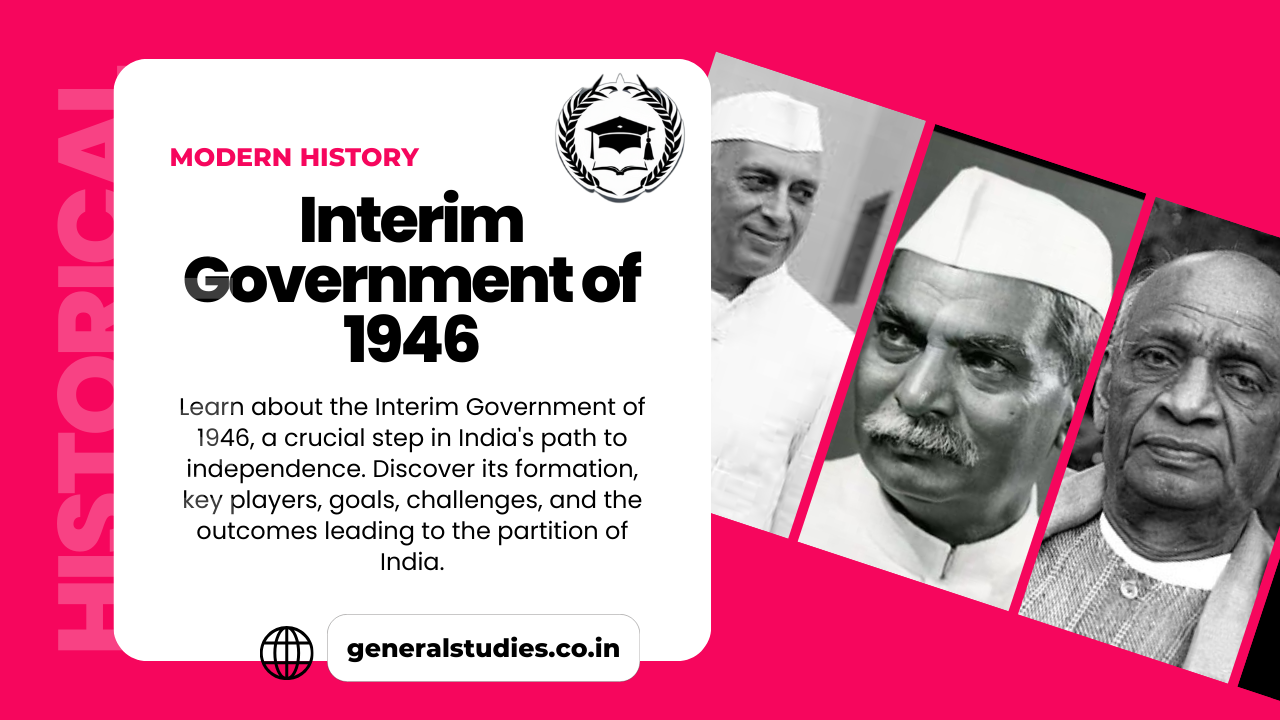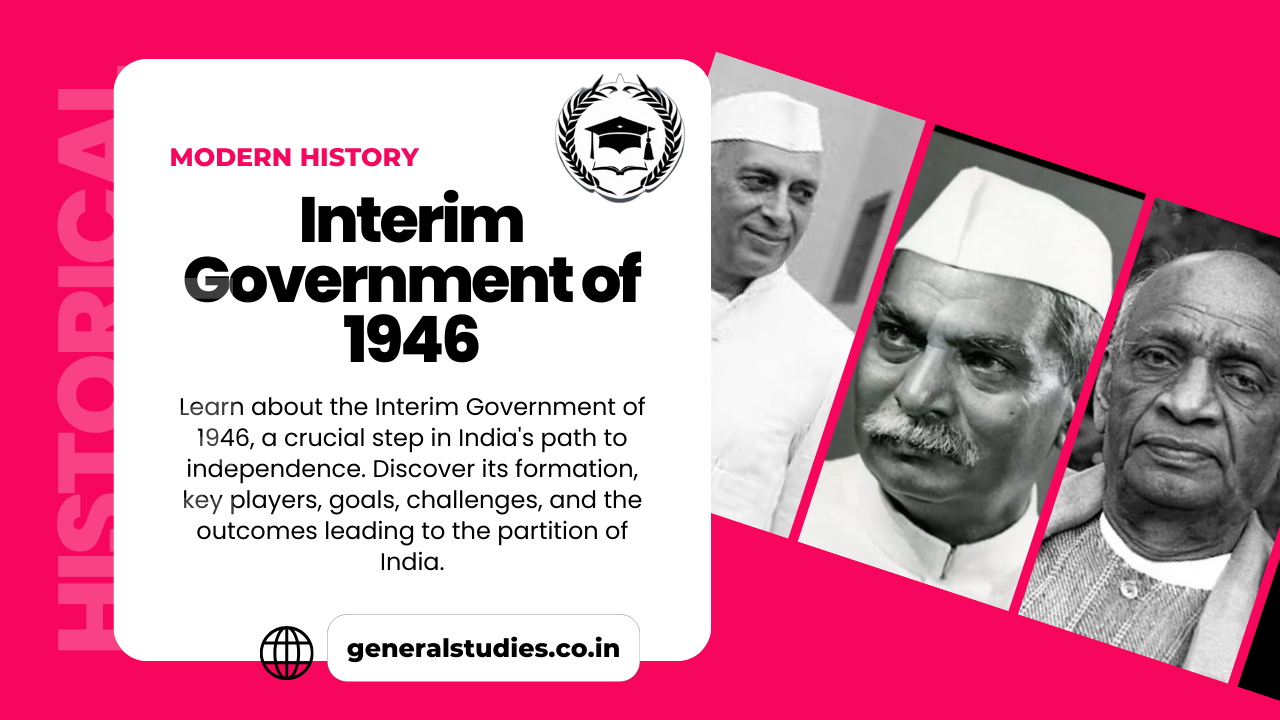Table of Contents

Introduction: Interim Government of 1946
The Interim Government of 1946 was a temporary governing body formed to oversee India’s transition from British rule to independence. Led by Jawaharlal Nehru and including leaders from the Indian National Congress and the Muslim League
Formation of the Interim Government
Formation Date: The Interim Government was formed on September 2, 1946.
Background of the Interim Government of 1946
The background to the formation of the Interim Government lies in India’s long struggle for independence from British rule. Several key events and factors led to its establishment:
- World War II and India’s Role:
- During World War II (1939-1945), the British government involved India in the war without consulting Indian leaders, which angered many.
- The Indian National Congress launched the Quit India Movement in 1942, demanding an immediate end to British rule. This movement resulted in widespread protests, but the British government responded with harsh repression, jailing many leaders including Mahatma Gandhi and Jawaharlal Nehru.
- After the war, Britain was weakened both economically and politically, and it became clear that holding on to India was no longer sustainable.
- Cripps Mission (1942):
- In 1942, the British government sent the Cripps Mission to India to negotiate with Indian leaders, offering a plan for self-government after the war. However, the Indian National Congress rejected it because it did not offer full independence.
- Simla Conference (1945):
- In 1945, British officials invited Indian leaders to the Simla Conference to discuss the formation of an interim government. However, the talks failed because of differences between the Indian National Congress and the Muslim League, particularly over how representation would be allocated.
- Post-War Economic and Political Situation:
- After World War II, the British were facing serious economic challenges at home, and the cost of maintaining their empire in India was becoming a burden.
- Meanwhile, India was witnessing growing discontent, with rising tensions between Hindus and Muslims, particularly over the question of partition (whether India should remain united or be divided into two countries, India and Pakistan).
- Putting Pressure for Independence:
- By 1946, there was intense pressure from Indian political leaders and the public for the British to leave.
- The British government sent the Cabinet Mission to India in March 1946 to work out a solution for a peaceful transfer of power. The mission proposed a plan for India’s future, which included the formation of an interim government and a Constituent Assembly to draft a new constitution.
- Formation of the Interim Government:
- In June 1946, the Indian National Congress agreed to participate in an interim government, though with some reservations. The Muslim League initially refused, demanding a separate country for Muslims (Pakistan), but later joined the government in October 1946 after further negotiations.
- On September 2, 1946, the Interim Government was officially formed, with Jawaharlal Nehru as its leader.
Purpose of the Interim Government of 1946
The purpose of the Interim Government of 1946 was to act as a temporary governing body to help India transition from British colonial rule to self-governance and eventual independence. This government had several key objectives:
- Self-Rule: The Interim Government was the first step toward granting Indians more control over their affairs.
- Constituent Assembly: One of its primary tasks was to oversee the creation of a Constituent Assembly. This assembly was responsible for drafting the Constitution of India.
- Managing Administration: The Interim Government was expected to run the administration of India including handling day-to-day governance, law and order, and crucial sectors like finance, defence, and agriculture.
- Negotiation with the British: Another key goal was to continue negotiating with the British authorities about the terms of India’s independence. The British government wanted a smooth transfer of power and believed this arrangement could prevent chaos.
- Maintaining Unity: One of the most challenging purposes was maintaining unity among different political factions in India, especially the Indian National Congress and the Muslim League, which had major differences in vision for post-independence India.
- Avoiding a Power Vacuum: The British wanted to ensure there wouldn’t be a power vacuum or widespread chaos in India as they withdrew. The Interim Government helped ensure there would be a stable authority in place while the final arrangements for independence were made.
Cabinet of the Interim Government of 1946
- Indian National Congress: The Congress had the majority of seats in the government. It had long been the leading party in India’s freedom movement and sought a united India after independence.
- Muslim League:
- Initially, the Muslim League refused to join the Interim Government, as it demanded a separate Muslim state (Pakistan). However, under pressure, the League eventually joined in October 1946.
- The League’s participation, led by Liaquat Ali Khan, was key in ensuring Muslim representation during this transitional phase.
- Independent Members: A few independent members, representing minority groups like the Sikhs, were also included to ensure a broader representation of India’s diverse population.
The Interim Government of 1946 included prominent leaders from both the Indian National Congress and the Muslim League, along with some independent figures. The key players were:
- Jawaharlal Nehru:
- He was appointed as the Vice President of the Executive Council, which made him the de facto head of the Interim Government.
- Nehru was a leading figure in the Indian independence movement and later became India’s first Prime Minister.
- Sardar Vallabhbhai Patel:
- A senior leader in the Indian National Congress, Patel was in charge of the Home Affairs portfolio.
- He played a crucial role in maintaining internal security and uniting the princely states with independent India after partition.
- Dr. Rajendra Prasad: Prasad, another Congress leader, was responsible for Food and Agriculture. He later became the first President of India after independence.
- Liaquat Ali Khan:
- Representing the Muslim League, Liaquat Ali Khan took charge of the Finance portfolio.
- He played a key role in advocating for Muslim interests during the transition to independence and later became the first Prime Minister of Pakistan.
- C. Rajagopalachari: He handled the Education portfolio and was a senior Congress leader, known for his intellect and administrative capabilities.
- Baldev Singh: Singh was in charge of the Defense portfolio. He represented the Sikh community and played a role in managing military affairs during a period of increasing communal tension.
- Other Members:
- Jagjivan Ram (Congress) handled Labour and worked on policies for improving labour conditions.
- John Matthai was in charge of Industries and Supplies.
First Interim Cabinet
| Minister | Department |
|---|---|
| Jawaharlal Nehru | Vice-President of the Executive Council External Affairs and Commonwealth Relations |
| Vallabhbhai Patel | Home, Information and Broadcasting |
| Baldev Singh | Labor |
| Dr John Matthai | Industries and Supplies |
| C Rajagopalachari | Education |
| CH Bhabha | Labour |
| Rajendra Prasad | Food and Agriculture |
| Asaf Ali | Railways |
| Jagjivan Ram | Labour |
| Liaquat Ali Khan Shanmugam Chettiar (after Liaquat Ali’s resignation) | Finance |
| TT Chundrigar | Commerce |
| Abdur Rab Nishtar | Communication |
| Ghazanfar Ali Khan | Health |
| Jogendra Nath Mandal | Law |
Reconstituted Cabinet
Here is the reconstituted cabinet of 15 October 1946, composed of representatives from major political groups in India, but it had a challenging start because of political rivalry.
| Office | Name | Party |
|---|---|---|
| Viceroy and Governor-General of India | The Viscount Wavell (15 October 1946 – 20 February 1947) | |
| The Viscount Mountbatten of Burma (21 February 1947 – 14 August 1950) | ||
| Commander-in-Chief | Sir Claude Auchinleck | |
| Vice President of the Executive Council | Jawaharlal Nehru | Indian National Congress |
| External Affairs and Commonwealth Relations | Jawaharlal Nehru | Indian National Congress |
| Home Affairs and Information and Broadcasting | Vallabhbhai Patel | Indian National Congress |
| Agriculture and Food | Rajendra Prasad | Indian National Congress |
| Commerce | Ibrahim Ismail Chundrigar | All-India Muslim League |
| Defence | Baldev Singh | Indian National Congress |
| Finance | Liaquat Ali Khan | All-India Muslim League |
| Industries and Supplies | John Matthai | Indian National Congress |
| Education | C. Rajagopalachari | Indian National Congress |
| Health | Ghazanfar Ali Khan | All-India Muslim League |
| Labour | Jagjivan Ram | Indian National Congress |
| Law | Jogendra Nath Mandal | |
| Railways and Communications, Post and Air | Abdur Rab Nishtar | All-India Muslim League |
| Works, Mines and Power | C. H. Bhabha | Indian National Congress |
Challenges Faced by the Interim Government
The Interim Government faced significant challenges during its short tenure:
- Communal Tensions: The most pressing challenge was the rise of communal violence between Hindus and Muslims. The divide between the Indian National Congress and the Muslim League reflected the growing tensions between their communities, making governance difficult.
- Partition Demands: The Muslim League’s demand for a separate Muslim state (Pakistan) led to constant friction with the Congress. This division made it hard for the two parties to work together effectively in the government.
- British Interference: Although the British had agreed to grant India independence, they still retained significant influence and often intervened in the decisions of the Interim Government.
- Economic Problems: India was facing severe economic challenges, including food shortages, unemployment, and post-war recovery issues. The government had to manage these problems with limited resources.
- Maintaining Unity: Keeping the different communities and political factions united was difficult. The Sikhs, Hindus, Muslims, and other minority groups all had different visions for India’s future.
- Lack of Trust: There was a lack of trust between the Congress and the Muslim League. The League often suspected that the Congress would dominate decisions, while Congress leaders were frustrated by the League’s demands for Pakistan.
Related Article:

